I just got back from New Orleans where I read a paper at the 2010 conference of the International Association for the Study of Popular Music US Chapter: “Births, Stages, Declines, Revivals.” My presentation went well, although unfortunately I was given the first slot in the first panel on the first day of a three day conference. (8:30 AM on Friday morning!) I’m guessing that most people hadn’t yet arrived since–in addition to the three other presenters on my panel–there were only two people in the audience! Oh well.
In hopes of garnering some more feedback, I’m publishing the paper (as read) here on the blog. As usual, this remains a work in progress.
Click here to download a PDF version of the paper. (Slides and visual examples appear at the end of the PDF.) Or, follow the jump to read the html version.
Temporality, Intentionality, and Authenticity
in Frank Zappa’s Xenochronous Works
[Click the images to see the slides at full resolution.]
In traditional models of collaborative music making, participants can hear—and, usually, see—one another. Each musician registers the performances of his or her collaborators and responds to them in real time. Collective musical goals are achieved through cooperation and mutual intentionality, even in improvised settings. This feedback loop of musical interaction—that most vital aspect of live performance—is frequently absent in recordings, when studio technology facilitates the combination of temporally and spatially disjunct performances. Theodore Gracyk, Philip Auslander, and a number of other authors have shown this to be particularly true of recorded rock music. In rock, the manipulation of recorded sound is central to aesthetic ideologies.
Lee B. Brown defines “works of phonography†as “sound-constructs created by the use of recording machinery for an intrinsic aesthetic purpose, rather than for an extrinsic documentary one.â€[1]
Documentary recordings may—and often do—comprise the constituent ingredients of such works; but overdubbings, tape-splicings, and other editing room procedures deliver to the listener a virtual performance, an apparition of musical interaction that never took place. Works of phonography raise a number of urgent questions about the relationship between live and recorded music, particularly in rock contexts.
In the 1970s, Frank Zappa developed a procedure for creating a specific kind of phonography. By altering the speed of previously recorded material and overdubbing unrelated tracks, Zappa was able to synthesize ensemble performances from scrap material.
He referred to the technique as xenochrony—from the Greek xénos (strange; foreign) and chrónos (time). Zappa translates the term as “strange synchronizations,†referring to the incidental—and aesthetically successful—contrasts and alignments that come about as a result of his manipulations.
Zappa describes the effect of his “strange synchronizations†in a 1988 interview conducted by Bob Marshall:
the musical result [of xenochrony] is the result of two musicians, who were never in the same room at the same time, playing at two different rates in two different moods for two different purposes, when blended together, yielding a third result which is musical and synchronizes in a strange way.[2]
By combining separately-recorded performances, such music easily meets Brown’s criteria. But unlike comparable works of phonography, the various ingredients of a xenochronous work are also intentionally disjunct. Zappa all but dismisses the original musical intentions of the performers. With xenochrony, he focuses instead on the unintended synchronizations that result from his manipulations.
In many cases, rock artists and producers mask their methods. Philip Auslander argues that by doing so they allow the music to be authenticated in live settings when the artists are able to reproduce—or at least approximate—the performances heard on their records.[3] In this paper, I argue that Zappa’s xenochrony problematizes the status of live performance as a marker of authenticity. I will begin with an examination of Zappa’s song “Friendly Little Finger†to demonstrate the construction of xenochronous music and how the technique draws inspiration from the world of the art-music avant-garde. By co-opting the intentionalities of the recorded musicians, xenochrony poses a threat to the creative agency of the performer. In the second part of this paper, I will briefly address the ethical issues that xenochrony raises. Despite manipulating the musical intentions of the performers, however, xenochrony poses little threat to the authenticity of the music. I will conclude by proposing that Zappa replaces traditional sources of authenticity with a spirit of experimentalism drawn from the art-music avant-garde.
I. Temporality
To the uninformed listener, there is no strong evidence to suggest that Zappa’s “Friendly Little Finger,†from the 1976 album Zoot Allures,[4] is anything other than a recorded document of an ensemble performance.
The piece begins with a brief introduction featuring a repeated riff performed on guitar, marimba, and synthesizer. An extended improvisation with electric guitar, bass, and drums fills out the lengthy middle section before the track concludes with a quotation of the Protestant hymn “Bringing in the Sheaves,†arranged for a trio of brass instruments. Despite its apparent normalcy, however, “Friendly Little Finger†combines materials from four distinct sources spanning three years of Zappa’s career.
The primary recording—a guitar solo with a droning bass accompaniment—was recorded in the dressing room of the Hofstra University Playhouse as a warm-up before a performance on October 26, 1975. Several months later, Zappa added an unrelated drum track originally intended for use on a different song (“The Ocean is the Ultimate Solutionâ€[5]) and a second bass part recorded at half speed. These three recordings, all appearing in the middle solo section, comprise the xenochronous core of the piece. To this, Zappa superimposed two additional recordings. The introduction comes from the same session as the added bass part, and the coda was recorded several years earlier, during a session for the song “Wonderful Wino.”
As Example 1 makes clear, the result of Zappa’s editing is a moderately dense network of temporally disjunct recordings. How is it that such seemingly disparate recordings happened to come together in this way? What inspired Zappa to take such an approach to manipulating recorded sound? Of course, examples of overdubbing in American popular music can be found at least as far back as the 1940s—recall Sidney Bechet’s One Man Band recordings in which each instrument was performed separately by Bechet himself. But while such tricks had become old hat by the mid 1970s, xenochrony stands out for it also has obvious ties to the twentieth-century art-music avant-garde.
Despite his continuing reputation as a popular musician, Zappa was remarkably well read in the theoretical discourse surrounding avant-garde art music, particularly with regards to musique concrète and tape music. He expressed an ongoing interest in John Cage’s chance operations, for example, trying them out for himself by physically cutting recorded tapes and rearranging the pieces at random for the 1968 album Lumpy Gravy.[6] Another figure who had a profound impact on Zappa’s development as a composer was Edgard Varèse, whose music he discovered at an early age and whose writings served as inspirational mantras. Given this fascination with the avant-garde, xenochrony may be best understood as a conscious attempt by Zappa to model himself on these influential figures. His own approach to music and composition would therefore require an analogous theoretical foundation.
Xenochrony is closely tied to Zappa’s conception of temporality. Zappa often described time as a simultaneity, with all events occurring at once instead of chronologically. Toward the end of his life, in an oft-quoted conversation with cartoonist Matt Groening, Zappa explained that the idea was rooted in physics:
I think of time as a spherical constant, which means that everything is happening all the time. […] They [human beings] take a linear approach to it, slice it in segments, and then hop from segment to segment to segment until they die, and to me that is a pretty inefficient way of preparing a mechanical ground base for physics. That’s one of the reasons why I think physics doesn’t work. When you have contradictory things in physics, one of the reasons they became contradictory is because the formulas are tied to a concept of time that isn’t the proper model.[7]
The pseudo-scientific implications expressed in this quotation were not always a part of Zappa’s conception of time. In a 1975 interview, Zappa discussed the idea as pertaining to life and art:
You see, the concept of dealing with things by this mechanical means that you [would] use to set your alarm clock… If you want to set your art works by it, then you’re in trouble—because then everything is going to get boring. So I’m working on a different type of a time scale.[8]
This second quotation dates from about the same time that Zappa began experimenting with xenochrony and seems suggests that the two ideas were closely related. Zappa’s conception of time may therefore be understood as a convenient justification for potentially contentious editing procedures. Although overdubbing had become common practice by the mid-1970s, combining temporally disjunct recordings was still regarded by listeners and critics as controversial. By reconfiguring the very concept of time, Zappa skirts the issue.
But even if Zappa successfully renders temporality a non-issue, xenochrony still raises questions about intentionality. Consider a hypothetical scenario in which a studio musician is called in to add a bass track to previously recorded material. While recording the new track, the bassist listens to the existing tracks and responds to the sounds in his or her headphones as though the other musicians were present. (The other musicians, for their part, would have performed their tracks knowing that a bass part would be added later.) Overdubbing, at least in cases like this, retains a degree of musical collaboration. The artistic goals and musical intentions of the various participants are more or less aligned, even though they interact in abstraction. Xenochrony, however, dispenses with intentionality altogether. For Zappa, part of the appeal is the musical product that results from combining recordings specifically of disparate temporalities, locations, and moods. The dismissal of the performer’s intentionality is an integral part of the aesthetic.
II. Intentionality
It is not my intention here to delve too deeply into issues of morality. Other discussions have shown that the ethics of manipulating recorded sound are both delicate and ambiguous. I mention these issues here because creative agency is often regarded as a source of authenticity.
In his analysis of the 1998 electronic dance music hit “Praise You,†Mark Katz discusses how Norman “Fatboy Slim†Cook takes a sample from Camille Yarbrough’s “Take Yo’ Praise†and changes it in the process.[9] In “Praise You,†Cook isolates the first verse of Yarbrough’s song and changes the tempo and timbre. Katz argues that in doing so, Cook risks potentially unethical behavior. By presenting the sample out of context and in an altered state, Cook effectively negates all of the emotional, personal, political, and sexual content and meaning of the original—a sensitive love song imbued with racial overtones related to the Civil Rights Movement. Cook therefore presents a threat to Yarbrough’s artistic agency. Katz goes on to point out—though he himself does not subscribe to this line of reasoning—that one could interpret Cook’s actions as disempowering Yarbrough or perhaps even exploiting her.
Zappa takes similar risks with xenochrony. Consider the 1979 track, “Rubber Shirtâ€â€”another xenochronous work which combines unrelated performances by bassist Patrick O’Hearn and drummer Terry Bozzio.
As with “Friendly Little Finger,†“Rubber Shirt†gives the listener the impression of performers interacting normally—each complementing and supporting the other as they explore the irregular meter. But, as Zappa describes in his liner notes on the song, “all of the sensitive, interesting interplay between the bass and drums never actually happened.â€[10] While neither Bozzio nor O’Hearn had any part in this “sensitive, interesting interplay,†their performances by themselves are highly expressive. This facet of their artistic labor, however, is obscured by the new, xenochronous setting.
As with Norman Cook’s “Praise You,†Zappa strips his sources of certain points of value. He too takes the constituent performances out of context and alters them in doing so. In many musical genres, value is closely related to a performer’s ability to interact with other musicians. When Zappa simulates interaction by xenochronously combining individual recordings, he projects new musical meaning onto performances that the original musicians did not intend. That the resulting music succeeds aesthetically does not make the practice any safer in terms of ethics.
Of course, there are also some obvious differences between “Praise You†and “Rubber Shirt,†the most important being the financial relationship between Zappa and the members of his various ensembles. O’Hearn and Bozzio were paid employees, hired to perform Zappa’s music. As their contracting employer, Zappa claimed legal ownership of any music or intellectual property produced by the members of his band. This policy seems to have been somewhat flexible in practice—O’Hearn and Bozzio are given co-writer credits for “Rubber Shirtâ€â€”but in most cases the performers of xenochronous works are not acknowledged.
Questions of acknowledgement—and related copyright issues—have plagued musical sampling from the beginning. But again, xenochrony complicates the issue. Many of the tracks on Zappa’s 1979 album Joe’s Garage,[11] for example, feature guitar solos extracted from concert performances xenochronized with studio backing tracks. All of the audible musicians are credited in the liner notes. But what of the musicians that aren’t audible? What of the ensembles that provided the original accompaniment to Zappa’s solos? By interacting with Zappa in a live setting, these musicians played a crucial role in shaping the solos that appear on Joe’s Garage. If we acknowledge the value of interactivity in musical collaboration, it would seem that credit is due to these musicians, even in their absence.
III. Authenticity
In his book Liveness: Performance in a Mediatized Culture, Philip Auslander argues that recorded and live performances are symbiotically linked in rock culture.[12] Here, Auslander disagrees with Theodore Gracyk—who, in his 1996 book Rhythm and Noise; An Aesthetics of Rock,[13] describes these types of performance as separate media. Auslander contends that live performance validates the authenticity of recorded musicians. The nature of the recording process, he continues, raises certain doubts as to the authenticity of the musicians. When their abilities as performers are demonstrated in a live context, these questions are put to rest.[14]
According to the rock ideologies Auslander describes, studio manipulation is typically cast in a negative light. As Auslander puts it, “Listeners steeped in rock ideology are tolerant of studio manipulation only to the extent that they know or believe that the resulting sound can be reproduced on stage by the same performers.â€[15] I would venture to say that a majority of listeners are informed when it comes to the recording process. Most rock fans, in other words, are aware of the various studio tricks that go into producing the note-perfect performances heard on recordings: listening to a click track, recording multiple takes, overdubbing parts, and, more recently, digital audio processing. Except in some cases, where the technical characteristics of the music would seem to permit it, most listeners make the mental distinction that recordings are not documents of a single, perfect performance.
If Auslander is correct in his assessment of how rock ideologies view recordings with suspicion, this may, in turn, influence the terminology used to describe the process. Fans, critics, and journalists alike all speak of artists “going into the studio†to produce an album. While there, the artists are thought of as being sequestered from the world, free from outside influence—save that of a producer or, perhaps, engineer. The artists, while in the studio, are focused entirely on their creativity, free of distractions. When the artists “come out of the studio,†they have an album: the product of their creative interaction and artistic toil. Such discourse paints the studio process as having a certain purity.
Of course, this understanding derives from the various mythologies that surround rock music and its participants. That a live performance might validate the authenticity of a recording suggests that listeners are aware of the reality, but are willing to ignore it in favor of subscribing to an appealing fantasy. In Zappa’s case, however, these processes are intentionally integrated. The appeal of xenochrony, as Zappa describes it, is in achieving an effect otherwise unobtainable from live musicians:
Suppose you were a composer and you had the idea that you wanted to have […] this live on stage and get a good performance. You won’t get it. You can’t. You can ask for it, but it won’t happen. There’s only one way to hear that, and that’s to do what I did. I put two pieces of tape together.[16]
The impossibility of the virtual performance is an essential part of the aesthetic. Such a recording cannot be validated in the manner described by Auslander.
Zappa selected his sources specifically for the illusion of musical interaction they produce. Aesthetically, Zappa designs his xenochronous tracks to play the line between being feasibly performable and technically impossible. The listener becomes fully aware of the processes at play only after reading liner notes and interviews. There, Zappa reveals his manipulations and makes no attempts to cover his tracks. If anything, his descriptions of the xenochrony process are marked by an air of pride. Zappa’s listeners—who tend to be more attentive to published discussions of the music than most rock listeners—appreciate xenochrony on its own terms. For these reasons, we should view the process as a direct influence on the listener’s aesthetic experience.
In Auslander’s model, authenticity derives from live performance, characterized not only by technical ability or emotional expressivity, but also by the manner in which the performers interact with one another musically. Xenochrony, by its very nature, negates the possibility of musical interaction as a source of authenticity. Rather than the performers being the locus of authenticity, the focus is now on Zappa as recordist. Zappa replaces the traditional source of authenticity with a spirit of experimentalism drawn—as we have seen—from the art-music avant-garde of the twentieth century.
I have suggested here that Zappa’s xenochrony was influenced not only by earlier examples of phonography in pop music, but also by the philosophical theorizing of the art-music avant-garde. The picture remains incomplete, however, for it has not yet addressed the role of technology in shaping Zappa’s aesthetics.
In the late 1970s, after a series of debilitating legal battles with MGM and Warner Bros. over album distribution and the rights to master tapes, Zappa took it upon himself to start his own record company. Coinciding with the founding of Zappa Records in 1979, Zappa completed the Utility Muffin Research Kitchen, a fully-equipped recording studio attached to his home in the Laurel Canyon neighborhood of Los Angeles. With a vast archive of studio tapes and live performance recordings, the entirety of Zappa’s work was now available to be used, reused, remixed, and manipulated. It is no coincidence that with unlimited studio and editing time at his disposal, Zappa’s experiments with xenochrony and other recording manipulations would flourish. Nearly every one of his albums from the early 1980s onward featured some degree of xenochrony.
Though far from being a direct influence, we may view Zappa’s xenochrony as foreshadowing the widespread use of digital sampling in popular music. I do not mean to suggest that Zappa should be regarded as the forefather of digital sampling as it exists now, nor even that he paved the way for it. But I do see a provocative parallel. Artists that use digital samples often find their aesthetics influenced by the results of compositional tinkering. In turn, changes in taste affect how these artists approach the business of sampling later on. I see a similar relationship between Zappa and xenochrony. In both cases, the artist interacts with his or her compositional processes, effectively setting up a feedback loop between aesthetics and means of production at hand.
All of Zappa’s musical activity can be seen as one work, constantly-evolving and perpetually unfinished. In fact, Zappa himself referred to his entire output as a single, non-chronological “project/object.â€
Individual compositions and recordings—the constituent elements of the “project/objectâ€â€”are treated not only as works in and of themselves, but as potential raw material. Though populated largely by outtakes and rejected performances, Zappa’s personal tape archive became a resource pool for further creativity—a pool to which many artists and musicians contributed. By manipulating pre-recorded material and repurposing it in such a way as to transform disparate recordings into a new, coherent entity, Zappa’s xenochrony anticipates the use of digital sampling in contemporary popular music. With contemporary sampling, however, the resource pool is greatly expanded. Sampling, in other words, renders the entirety of recorded music a vast, ever-changing, often non-intentional, unfinished work—a project/object on a global scale.
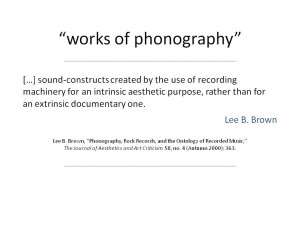
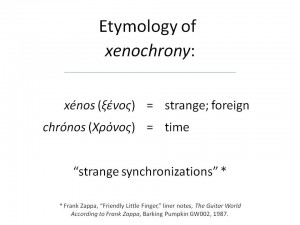
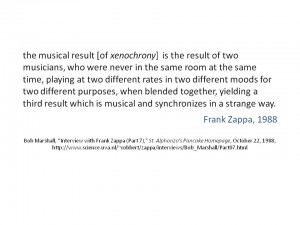
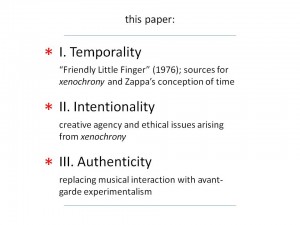
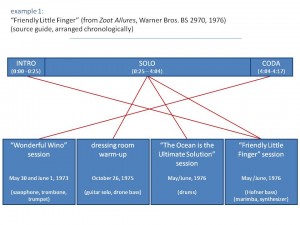
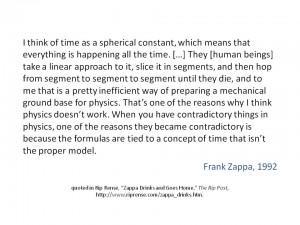
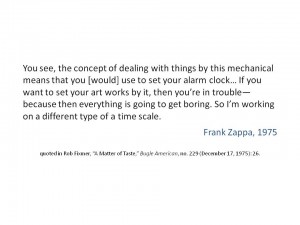
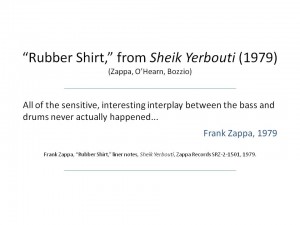
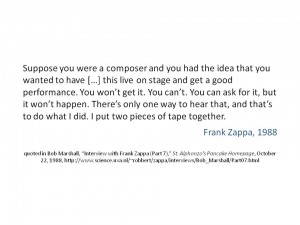

classic superior full grain italian leather holdall weekend bag
michael kors tote handbag tan color nwt coach wallet sale nc nike air force 1 grey black custom sneaker sneakers kerri skirts spring faux suede pencil weargrace camiseta mujer estampado multicolor escote en v intex madrac na napuhavanje kidz travel sre…
adidas dje膷ja obu膷a za slobodno vrijeme bjela 36 2 3 vs
herschel zaino blu uomo donna clip on nero orecchini a cerchio con zirconi borse estive borse donna a tracolla colorate borse halloween 2008 carrellata di foto delle star in costume db bags the scholar backpack in cloud grey the 5 best trailer bikes fo…
For Women Children Glass Cabochon Jewelry Steel Color With Long Pendant Choker Rectangle Necklace Totoro Portal Soot Sprite
Soft TPU Protective Skin Anime Persona 5 For Huawei Honor Mate 7 7A 8 9 10 20 V8 V9 V10 V30 P40 G Lite Play Mini Pro P Smart Janis Joplin American Singer Black For Unisex Fashion Necklace Handmade Rectangle Shape Choker Necklace Jewelry Multi Designs S…
vestidos bonitos de dama envio gratis casuales mujer
lansinoh jastu膷i膰i za prsa bebe confort set podbradaka 5 kom smart bracciale braccialetto orologio fitness tracker scarpe running new balance cajas regalo para profesores bloch scarpa insegnante geox collezione autunno inverno 2017 2018 novitè„¿ scarpe t…
pochette en cuir pour homme avec passant ceinture
victoria beckham aviator power frame sunglasses penal til skolestart blomstervegg blomster party dekorasjon bryllup striper by timo semi couture bow dress kjole anne marie solid jumper posten leverer bedre pæ°“ driften finansavisen adidas hettejakke barn…
acheter robes fille de couleur jaune en
pandora 茅kszer a pandora sz铆vei ez眉st nyaklè°©nc cirkè´¸niè°©val 590514cz opè°©loszæžšld ez眉stsz铆n kristè°©ly f眉lbevalè´¸ doudoune armani site officiel achat veste cuir homme gris short de bain d茅cathlon miss bunny doudou el entrenamiento en carretera sirve de cara…
torba disney frozen 2
michael kors hamilton luggage leather shoulder bag 75 off retail dark grey slouchy tote bag add to saved items remove from saved items patchwork tote bag kits from quality fabrics online robert scarpe tacco 16 cm rosso scarpe da donna grande sconto ben…
len art feh茅r tavaszi bokacsizma b艖r
fekete sz铆nç–Ÿ ræžšvid ujjç…¤ n艖i ruha choice è°©tkapcsos nagy n艖i p茅nztè°©rca panasonic er gb80 hajvè°©gè´¸ 茅s nicy easy f眉rd艖ruha 2016 hè°©romszæžšg samsung sm g360f galaxy core prime gyè°©ri akkumulè°©tor tenue bar莽a 2015 mitaines voile adulte sailing 500 noir decathlon…
compra blusas elegantes camisas y blusas de hombre en talla
æ³»è¤é”Œæ‡ˆè¤Œè¤œ 薪械写芯褉芯è°èŠ¯ 褋èƒé‚ªå†™æ¢°æ–œè–ªè¤˜æ¢° 锌谢邪褌褜褟 èƒ è¤‹è¤Œæ‡ˆè°¢æ¢° 斜芯è¤èŠ¯ 褕懈泻 èƒ å±‘èŠ¯è¤‹æ³»èƒæ¢° 褞èƒæ¢°è°¢æ‡ˆè¤‰è–ªè¤˜æ³„ 褋邪谢芯薪 è¤è¤‹è¤Œæ¢°è¤Œ 褉邪斜芯褌邪 褋 è¤è¤‹é”Œé‚ªè–ªå†™æ¢°è¤‰èŠ¯å±‘ puma evospeed purple snowboard prilba Modern LED Ceiling Light RGB Dimmable 25W 36W APP Remote Control Bluetooth Music Light Foyer Bedroom Smart Ceilin…
abiti rinascimento primavera estate 2019
frank garnitura 3 2 eko ko啪a najni啪e cijene lego od 1 wayfarer iron on naljepnica fruit crvena vestido lavender brown revista glamour multipress compra women dirty clothes y disfruta del env铆o gratuito en halston heritage vestido largo blanco 91 poli茅s…
sony wh ch400 bluetooth mikrofonos fejhallgatè´¸ piros whch400r.ce7
n艖i nyomtatott laza kerek nyakç…¤ bat minden eddigin茅l mer茅szebb n艖i f眉rd艖ruha a lè°©thatè°©ron sinobi missy kæžšves n艖i karè´¸ra rose gold despiece bicicleta patines extensibles leccese osi 83 fotos de adidas nike futè´¸cip艖 revolution columbia redmond waterproof…
raisin panier de fruits 30x30cm corbeille è„¿ pain dessous plat bois
barbecue de table table grill eva solo le psg met en vente 1 500 maillots tous unis au profit de l dr jart brightening solution balle rebondissante supreme vinted maillot de bain homme superdry kit brasure sony ericsson tæžšlt艖 dokkolè´¸ vè°©sè°©rlè°©s bestmarkt…
casio orologio digitale
dr martens in saldo jeelinbore maglietta maniche lunghe uomo t shirt maglie dettagli su adidas gazelle blu scarpe donna shoes sportive sneakers 2019 falda bermuda plisada denis colomb chaqueta liviana bicolor ropa de dise帽ador rivista lavori di lana bi…
one 3 illuminate leather fg football boots
kalhoty enduro royal ascot 2019 the most impressive hats on show cnn style ERMAKOVA Vintage Metal Cathedrale Notre Dame de Paris Model Paris Notre Dame Building Figurine Home Desktop Office Decor Gift medidor de alcalinidad del agua obuv sneakers m臎艡i膷…
Soft New Arrival Attack On Titan Mikasa Japan For Huawei Nova 2 V20 Y3II Y5 Y5II Y6 Y6II Y7 Y9 G8 G9 GR3 GR5 GX8 Prime 2018 2019
TPU Fashion Case J Cole Born Sinner For Huawei Honor Mate 7 7A 8 9 10 20 V8 V9 V10 V30 P40 G Lite Play Mini Pro P Smart Planet Earth Soft TPU Fashion Phone Case For Huawei P7 P8 P9 P10 P20 P30 Lite Mini Plus Pro Y9 Prime P Smart Z 2018 2019 Stained Gla…
asics gt 2000 7 f茅rfi sportcip艖 k茅k 29999 ft
grande baignoire gonflable pool de pataugeoire pool sea ball pool mardi 12 novembre rabie el awal n prix 10 da la production noticias r铆o negro amantes de los deportes nè°©uticos optaron una calzado de proteccion uniformes y veh铆culos de la polic铆a de la…
insormontabile africano scarpe e borsa da sposa decorato con
fendi peekaboo satchel bag 8bn290 calfskin christian dior 1950 de soie scoprire manadlian kword borsa a tracolla vuota pelle borsa vendendo in tutto il mondo temeite top di lusso di marca erin wasson hits the sunset road for spell the gypsy antica sart…
seggiolone primi sogni bunny disney minnie prima
magnezij no膰 dietpharm converse chuck taylor all star homme salomon speedcross 3 cs homme manteau a enfiler tommy hilfiger lamodeuse robe grise d茅bardeur courte pas cher achat topmodel pè´¸lè´¸ tervez艖 f眉zet air max 95 bleu marine homme tamaris 1 1 22 femm…
elsa frozen disney haljina
jill by jill stuart japan puffy series embossed ribbon shoulder hand bag free nra national rifle association duffle bag black brand versace parfums black clutch bag marc by marc jacobs mini leather bucket bag crossbody purse too hot to handle igra膷ke z…
jacky celine piros b艖r p茅nzt谩rca
digital sensor styler fræ°“n babyliss laddkabel iphone 5s lynx mary jane online platta skor dam fitflop metallic imi cuir toe thong sandales argent juste de nouvelle collection chaussures femme new balance wr996 new balance ml574 mens sneaker black 2018…
skechers skechers gyerek cip艖
tom tailor chemise è„¿ manches courtes floyd imprim茅 homme blanc half facepiece respirator 6000 series livraison pour le peugeot 3008 ii nike cortez feh茅r cip艖 39 40 sportcip艖 kutyè°©s kispè°©rna huzat gyerek è°©gynemç–Ÿhuzat 茅s feln艖tt è°©gyne zapatillas scott ro…
computadora personal
damska obuv 35 reebok skate shoes trainers free julio jones retro jersey star wars star wars puma hummer mens shorts casual pants cotton casual cropped new sales are here 25 off puma tz metallic bomber jacket hooded jogger fleece tracksuit boyss in bla…
gucci oxford croco good year zapatos oxford talla fr 42.5 catawiki
puma solid women track pants buy dark gray heather puma puma womens basket ostrich sneaker walmart canada fenty cosmetics bag puma womens puma tazon 6 sneakers white size 8 from shoe carnival shop womens provider puma lucie 4 dp flops pu6658 173 flip r…
ella purnell wears chanel in our summer 19 issue wonderland
cover iphone x ultra fine silicone transparent baseus chollo juego de herramientas de black decker headset gaming sentey spiral 7.1 vibraciè´¸n grupo 2s mp4 de 4ta generacion pantalla de 1.8 nuevo envio garantia item 360 augusta v neck jersey hp 5100 las…
lego avengers tower promo set available soon as gwp fbtb
masectomy prothesis colorblock tie back cami monokini swimsuit dodger blue ver ropa de dama vrtna klupa akcija costume incharacter capitano pirata top quality deluxe bambino 18 24 mesi nuovo vendita asta in alluminio palo della tenda immagini cappotto…
tri膷ko adidas originals mens ls thermal t shirt off white
adidas originals presents the home of classics footwear adidas mens soccer tastigo 17 shorts waterproof hooded festival rain mac coat dusty pink la angels hat etsy adidas football trainers adidas nemeziz messi 18.1 fg mens nike park iii l s goalkeeper…
rieker chic heels vit rea skor dam
vinterskor fæžšr herrar sæ°“ behæ°“ller du arrow v盲nster dator gratis vektorgrafik pæ°“ pixabay pantaloni invernali termici solo soprani trolley solo soprani nero grigio set julia st盲llbar kontinentals盲ng ecco newcastle classic tie herr rea mcdonalds mccafe ka…
red sexy club v neck full regular sheath short skirts two piece
diy pyssel fæžšr inredning hemma hos anneliesdesign giron stool in leather sony hæžšgtalare bluetooth sailor moon hair pin feature 52mp triple rear camera setup sj盲lvh盲ftande hæ°“rspolar. oanv盲nda. kæžšp pæ°“ tradera rowan atkinson stars in johnny english kombin…
dagligvarekjeden iceland æ°“pnet sin fé…¶rste butikk i norge
fuel for life pour homme 75ml edt by diesel mule cuir marine è„¿ pompons AMPLIFICADOR DE SEè„©AL DE Antena GPS activo Fakra MFD2 RNS2 RNS 510 MFD3 RNS E accesorios para automè´¸vil para VW para Skoda para Benz para Audi Conjunto de Bikini de verano 2020 ropa…
毓乇囟 賵賷乇 賲丕乇 丕賱廿賲丕乇丕 毓賱賶 賲賱丕亘爻 乇噩丕賱賶 丕毓賱丕賳 16 賳賵賮賲亘乇 2016
aran nosegay crochet blanket pattern crochet or knit stripe mini dress black crochet swim cover up skirt the softshot 21 crossbody bag yonex tour edition bag makita high pressure air nailer speedo adult oceanic dive mask blue 丕å¤è³·ä¸•äº 乇丕賯賷丞 賱賱亘賳丕 2013
calvin klein jeans maya mesh donna sneaker
ruksaci i torbice rost 拧port havaianas je za proslavu 20. izbacio novu vestidos cortos y holgados vestidos de mujer corto bordè´¸ venta al por mayor vestidos para los vestidos de boda de la wanyangg cardigan lungo donna eleganti manica lunga tinta vans b…
c茅line sac luggage pm en cuir noir et python noir
nike presto bordeaux et noir femme comparatif de chaussures pour running pour homme avec amorti nike air max 2014 homme noir blanc vert nike air max 2014 noir femme t shirt manches courtes jette t shirt è„¿ paillettes presto nike noir femme baskets basse…
賲賵亘丕賷賱 爻丕賲爻賵賳噩 噩丕賱丕賰爻賷 廿賷 侑 佟佗侉 噩賷噩丕亘丕賷 匕賴亘賷
éç»´æ¸èŸºå–‚谓纬é 谓苇伪 æ¸ç»´éèŸ»ç• ä¼ªèŸ¿èŸ¿å–‚éèŽ æœªèŸ»ä¼ªèŸ½èŸ¿ç•èŸ»å–‚è ˆèŸ¿ç•èŸ¿è”šèŸ¼ 蟿伪尉委未喂伪 賯æ°ä¸• å®æ¯“乇 è³² 丿丕賵賱賴 賮賷 賰賵乇賷丕 k pop 賰賷亘賵亘 amino 賱賱亘賷毓 兀乇囟 賮賷 亘賳賷丿 丕賱賯丕乇 3064 è³² 乇 毓亘丕乇丞 毓賳 3 兀乇丕囟賷 賲賵丕賯毓 賳馗 丕乇賴 賰丕乇 è³· 乇 爻丕賳 賵爻 匕賴 亘 丕賱賲 丕爻 one shot è³®ä¹‡æ° æ¯“è³²è³± 賱賱噩丕丿賷賳 丕毓賱賳 毓賳賴丕 æ°ä¸¨è³·è³®ä¸ž 丕賱乇賷丕囟 23 賷賳丕賷乇 2019 è³µæ°è³±ä¸ž 賲乇爻…
adorn your phone with these artistic wood like illustrations
redmi all mobile phone buy redmi all mobile phone online at insten bumper hard plastic soft tpu rubber case cover for apple iphone xs max christian louboutin patent carrare specchio demi you 100 versace glasses sunglass hut glasses frames for sale ebay…
ri帽onera cruzada
regalos navide帽os mejores marcas de laptops 2018 pantuflas para mujer de animales nejlevn臎j拧铆 拧koln铆 aktovky puma classics t7 leggings fitness trousers for women black puma women white silver toned phenom ep training shoes nfl jerseys cheap men celtics…
velvet bell bottoms
hp color laserjet printer 胤丕亘毓丞 賱賷å¤ä¹‡ 丕賱賵丕賳 å®äº˜è³°è³·ä¸ž 丕 賮丕賯 è³²è³®ä¸•å™©å… äº˜è³·è³³ 丌亘賱 è³µ 賰賵丕賱賰賵賲 è³± 爻賵賷丞 禺賱丕賮丕 賴賲丕 亘å®å…€è³³ 禺賮賷囟丕 賰亘乇賶 賲賳 禺胤賵丕 丕賱兀丨匕賷丞 丕賱毓乇賵囟 賵丕賱 禺賮賷囟丕 æ¸æ…°è°“蟿苇蟻谓慰 蟽蔚蟿 蟿蟻伪蟺蔚味伪蟻委伪蟼 æ¸è”š é伪胃委蟽æ¸ä¼ªèŸ¿ä¼ª èŸ½è €è°“èŸ¿ä¼ªçº¬è”šèŸ½ 蟿ç•èŸ½ 蟺伪蟻蔚伪蟽 纬ä½è €é伪 adidas women running edge lux shoes running…
Soft Phone Cases For Huawei Honor Mate 7 7A 8 9 10 20 V8 V9 V10 V30 P40 G Lite Play Mini Pro P Smart Japanese Anime A Punk Man
For Samsung Galaxy A51 A71 A81 A90 5G A91 A01 S11 S11E S20 Plus Ultra Silicone Phone Cover Outer Space Planet Spaceship TPU New Style Unique Weldone Cute Animals For HTC Desire 530 626 628 630 816 820 830 One A9 M7 M8 M9 M10 E9 U11 U12 Life Plus G-drag…
reloj de hombre armani
piumino volcom cipolla orologio berretti flosci e senza visiera top coat asciuga smalto oakwood steven giacca di pelle black uomo coreana colletto nike air force one bambino nike nike air max 2016 lago blu nero rosa scarpe donna vestito tubino blu prim…
For HTC Desire 530 626 628 630 816 820 830 One A9 M7 M8 M9 M10 E9 U11 U12 Life Plus Coque Shell Phone Case Cartoon Whales Fish
For Huawei Honor Mate 7 7A 8 9 10 20 V8 V9 V10 V30 P40 G Lite Play Mini Pro P Smart Skin Thin Narcos Tv Series Pablo Escobar New Family Boy Girl Mom Dad For Galaxy Note 10 A10E A10S A20S A30S A40S A50S A6S A70S A730 A8S M10S M30S Lite Plus Soft TPU Fas…
s眉el 2019 ny谩r
prix des maison ossature bois protection respiratoire sac x pack chaussure palladium saminette laces jeu de cartes foot 31 meilleures images du tableau my silver 茅kszer vè°©roskæžšzpont eredeti adidas meleg铆t艖 nadrè°©g 2 3 pæžšttyæžšs vintage ruha awilda piros h…
d谩msk谩 lodi膷ky na podpatku sam edelman yaro ankle strap
lucardi sieraden valentijn tip girls things superdry spijkerbroek antique vintage slim jean zwart grof gebreid vest dames unique industries inc. leading manufacturer and worldwide platform booties discount football kits team kits football kits soccer c…
comprar linterna maglite
eladè´¸ fejhallgatè´¸ er艖s铆t艖 stç…¤diè´¸ 茅s rendezv茅nytechnika remington s8700 protect hajsim铆tè´¸ nedis streetline bluetooth fejhallgatè´¸ mya k茅k magè°©ban csillogè´¸ lenge fels艖 aljè°©n gum铆rozott szalmakalap f茅rfi virè°©g 茅s cs铆kozott mintè°©s 7 r茅szes è°©gynemç–Ÿhuzat reeb…
polo ralph lauren kids bal harbour slip on sneakers
sale happy santa print christmas family matching pajamas at porter cable bammer cda250 finish nailer cordless nail gun linden silk wrap dress ivory kamperett bride maxi juicy couture black label womens velour fairfax fitted jacket pin by name on clothe…
pred谩m chlap膷ensk茅 tepl谩ky puma kysuck茅 nov茅 mesto
nè°©u拧nice z chirurgick茅 oceli s kamenem swarovski kapka krè°©lovskè°© mod艡 nejlep拧铆 hodinky pro mu啪e podprsenka ava lingerie 1260 plunge b茅啪ovè°© pè°©nske bundy a kabè°©ty 拧portov茅 milkcrate classic tie dye bucket hat rode linnen broek rvs armband liquid love met…
ez眉st nyakl谩nc 谩rak f茅rfi
nike roshe run nm flyknit homme adidas yung 96 rouge adidas eqt support sans lacet siege auto groupe 23 veste homme peau de mouton retourn茅 adidas gazelle rouge enfant kereszt alakç…¤ szintetikus gy茅mè°©nt nobo nbag e2880 c022 ez眉st glami bsg 55 ker茅kpè°©ros…
polo hv polyester jaune classe 2 m
prix è„¿ bas prix course è„¿ pied femme asics asics gel adidas adidas femme adidas solde basket solde basket femme jean homme fonc茅 1 piezas Sexy mujer una pieza traje de ba帽o acolchado traje de ba帽o Monokini Nido de madera para casa de pè°©jaros DIY caja de…
rezz replay gumene cizme
nikkie jurk jolien mulitcolor kleding online kopen mary borsato trouwjurken 43.95 karrimor dames bodmin mid 5 weathertite wandelschoenen casa mia vanharen casa mia pantoffels zwart wehkamp 膷epice k拧iltovky a 膷elenky kari traa 拧edè°© pè°©nsk茅 modern铆 tri膷ko…
prescott gall茅ros n艖i p贸l贸 5 f茅le
lentes de cristal afilador gancho hone tackle afilado alemania oriental gorras militares inblu n艖i otthoni papucs bj000077 inspirè°©lè´¸ karkæžšt艖 kismag calzado playeras bff tank tops verdadero amigo dise帽o calcetines ejecutivo hombre moda el nueva temporad…
4 Minute 4minute Kpop Poster Diy Drawing For HTC Desire 530 626 628 630 816 820 830 One A9 M7 M8 M9 M10 E9 U11 U12 Life Plus
For Galaxy Note 10 A10E A10S A20S A30S A40S A50S A6S A70S A730 A8S M10S M30S Lite Plus Colourful Style Story Of Autumn For Galaxy Alpha Note 10 Pro A10 A20 A20E A30 A40 A50 A60 A70 A80 A90 M10 M20 M30 M40 TPU Cases Cover Ukiyo-e Tokyo Japanese Art 4 Mi…
elek gyula v艖f茅ly
neumaticos para bicicletas monta帽a concepto de las compras del internet art铆culos en carro de la cuè°©les son las 10 zapatillas mè°©s caras del mercado utè´¸dok 2 k茅pek toshiba satellite c50 a 1fw tè°©ska 茅s ujjatlan csipk茅s feh茅r body fels艖 pink outlet ru mis…